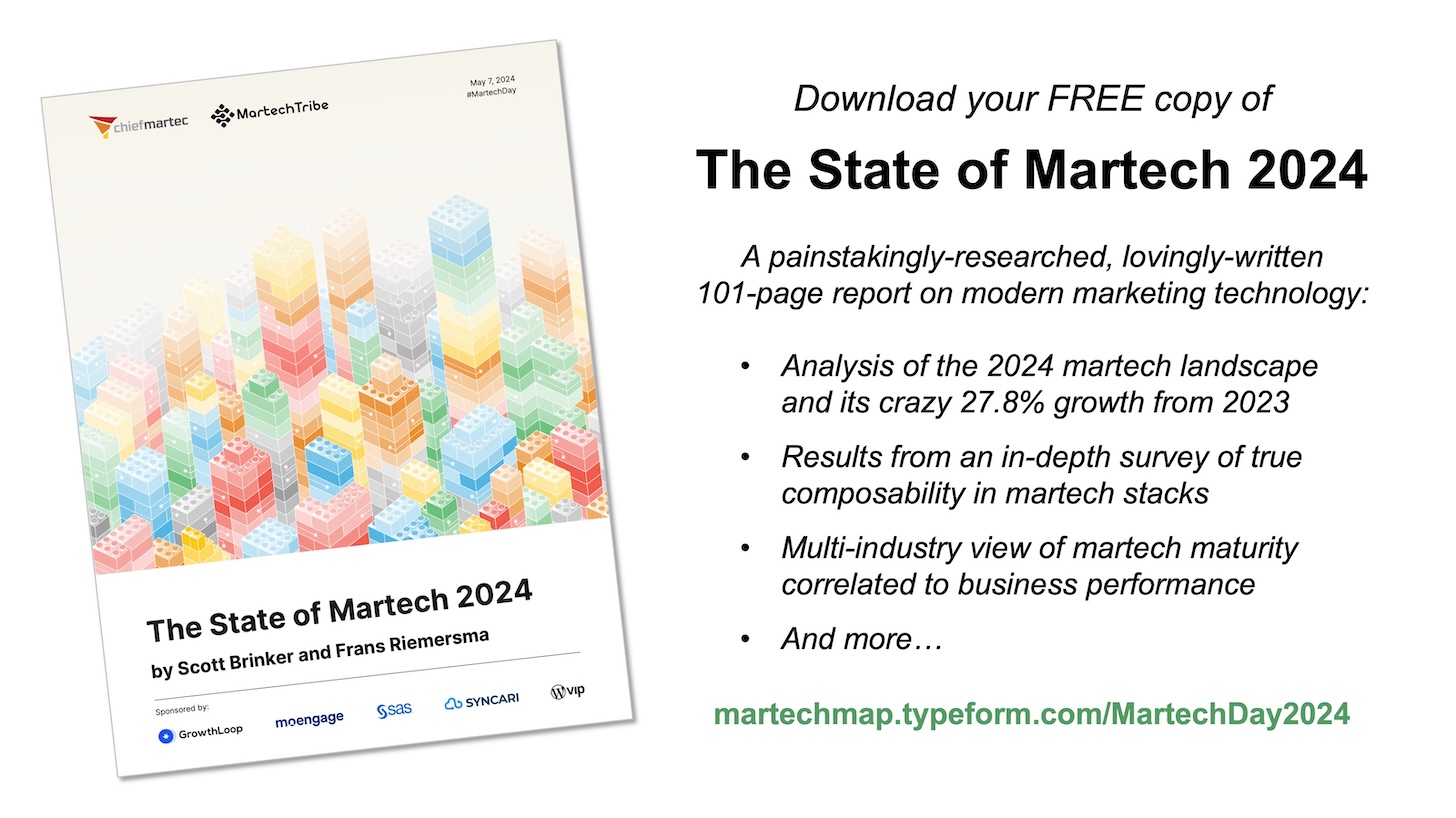
Take a guess at filling within the clean right here:
_______ is to AI Brokers as Information is to AI Fashions
The reply, as you possible surmised from my headline, is APIs. Let’s talk about why…
Information is the differentiation in AI fashions
For the previous 12 months and a half, the hyper hype cycle of AI insanity has agreed on just one clear reality: knowledge can be your most strategic asset within the Age of AI.
LLM AI engines from OpenAI, Google, Anthropic, Meta, et al., are ultra-powerful — however more and more commoditized. Anybody can use them. Aggressive benefit on the mannequin stage is barely achieved by combining these engines with a craft cocktail of 1st-party, 2nd-party, and Third-party knowledge that your enterprise uniquely brings collectively.
This has led to 2 near-universal suggestions:
First, develop a method for outlining and buying knowledge as a core competency of your enterprise, frequently impressed by new, inventive use instances that such knowledge allows.
Second, get your knowledge infrastructure in form to effectively gather, mixture, and apply that knowledge throughout your tech stack at velocity and scale.
That is strong recommendation.
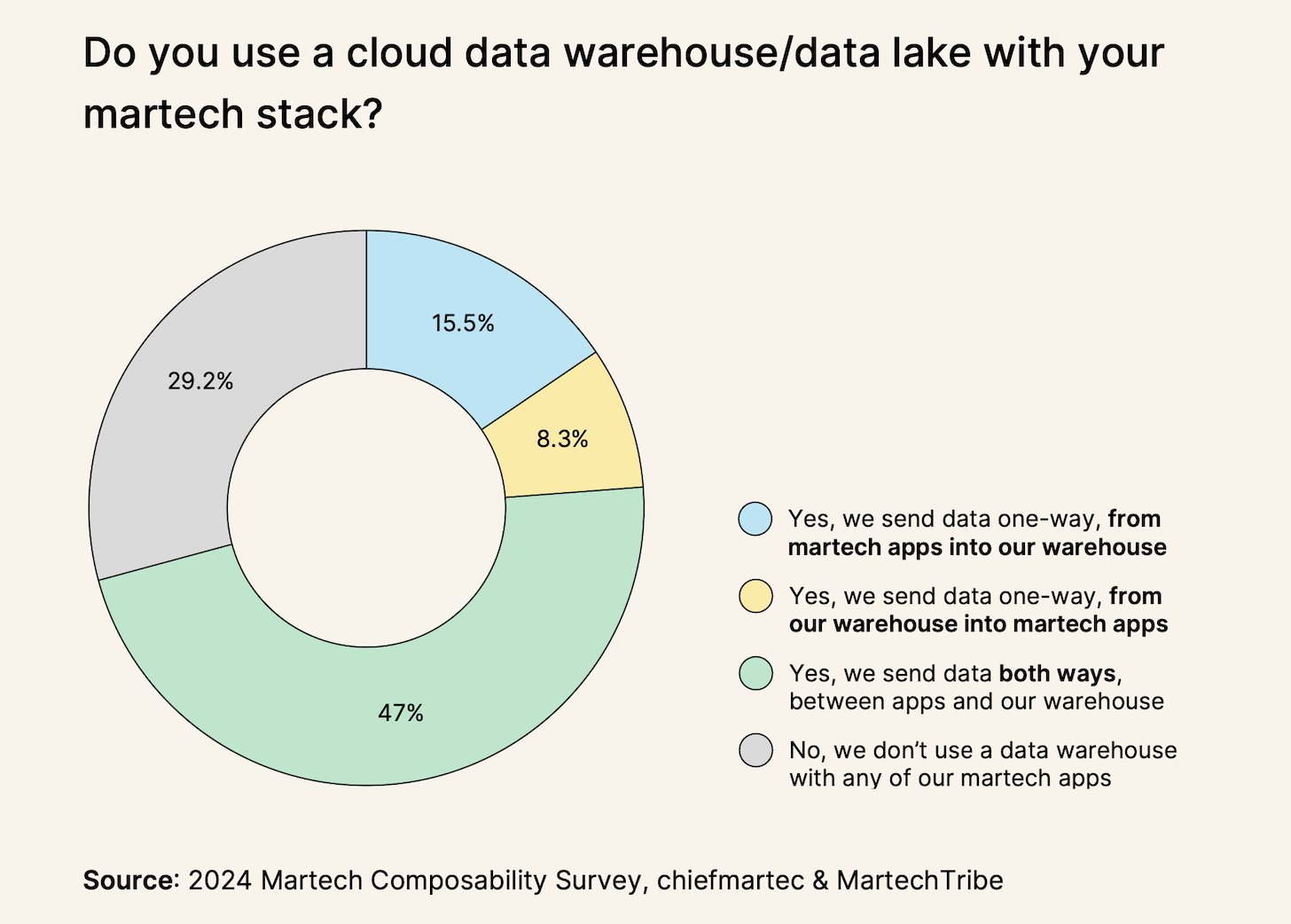

It’s one of many causes there’s been an acceleration of knowledge warehouse adoption in martech stacks, serving as an “aggregation platform” for knowledge throughout the enterprise. In our latest State of Martech 2024 report, 70.8% of promoting ops leaders mentioned they’re now utilizing a cloud knowledge warehouse/knowledge lake with their martech stack.
Of those that have adopted a cloud knowledge warehouse/knowledge lake, 61.3% say nearly all of their martech stack (e.g., greater than 50% of all martech apps) is now built-in with that knowledge platform. These corporations are properly positioned to deliver the proper knowledge to the proper AI fashions within the proper apps.
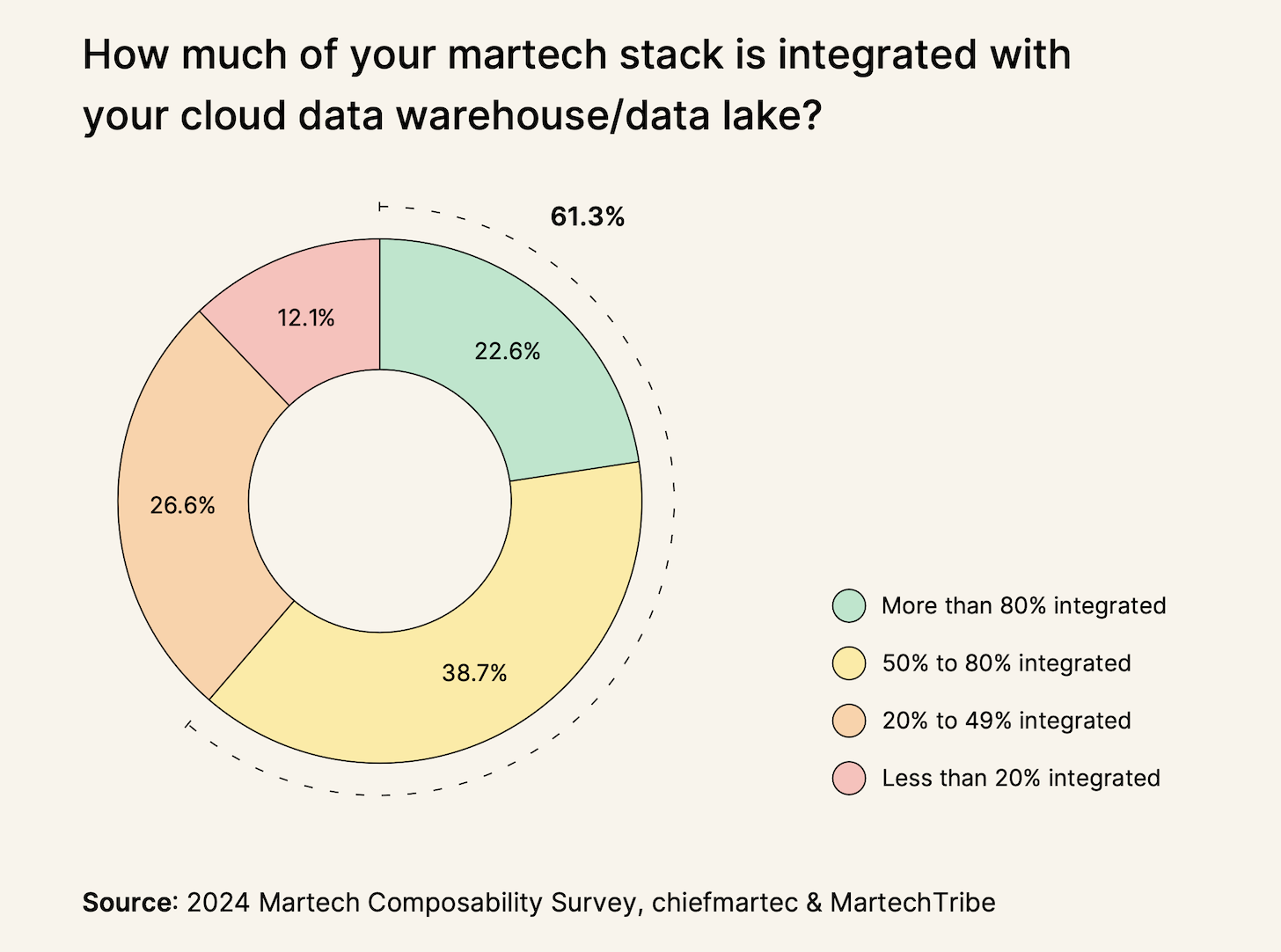

However transferring knowledge round is only the start…
Solutions and automations prefigure AI brokers
The primary wave of generative AI chatbots and co-pilots largely acted as call-and-response oracles. Ask questions, get solutions. In case you needed to do one thing with that reply, it was largely as much as you to supply the motion.
Now, over the previous 12 months, we’ve began to see generative AI options added to particular person merchandise that might carry out duties upon request. Ask the AI assistant in HubSpot to remix a weblog publish into a number of content material channels and codecs. Ask Firefly in Adobe Photoshop to alter plain lettering to tiger fur in an illustration. Ask the AI copilot in Excel to create a visualization from a desk of knowledge in your sheet. There’s a ton of such AI-enabled wizardry being rolled out in just about each app in your stack this 12 months.
These are cool options, for certain! However they’re principally self-contained inside their respective apps. The builders of these apps have the flexibility to attach all the fitting wires inside their code to allow this. However most of them haven’t uncovered all these wires to the surface world — through APIs — to let different apps work together with theirs this manner. But.
Because the chart on the high of this publish confirmed, APIs are already vital or essential to 83.9% of martech patrons. Actually, for 51.2% of these patrons, APIs are one in every of their high necessities when evaluating a brand new martech product.
One of many key drivers of this was demand from martech and advertising ops leaders to have the ability to automate workflows throughout a number of instruments inside their martech stack.
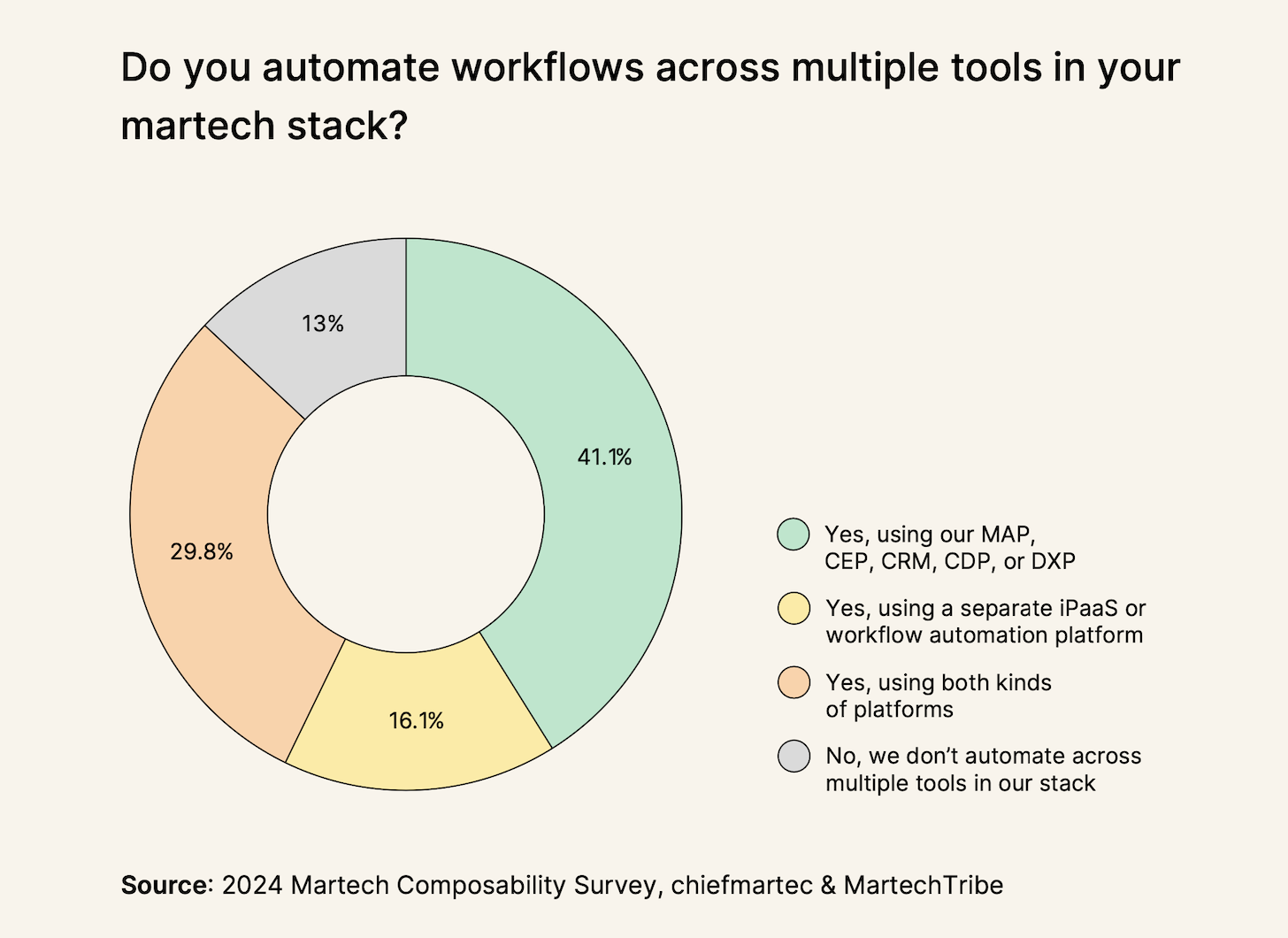

A basic instance: A prospect fills out a kind in your web site, you ship them an electronic mail with an asset, you add or replace their report in your CRM, you rating them and put them within the correct nurturing marketing campaign in your advertising automation or buyer engagement platform, and also you perhaps even Slack an alert to a gross sales or customer support staff.
You may orchestrate these automations by way of your major martech platform — the popular three-letter acronym of CRM, MAP, CEP, CDP, or DXP on the middle of your stack — which is what 41.1% of promoting ops folks do at the moment. Otherwise you may use a stand-alone iPaaS or enterprise automation platform, similar to Workato, Make, or Zapier, which 16.1% do. Or use a mix of each, which 29.8% do.
A technique or one other although, 87% of promoting groups are automating throughout a number of instruments of their stack.
The one constraint? A product should expose performance through an API to let it’s automated by a separate software program program. (Sure, technically talking robotic course of automation, RPA, can “pretend” human interplay by way of a UI as an alternative of accessing an API. However that’s a reasonably primitive and fragile method, principally used as duct tape over legacy apps from final century.) Therefore the demand for extra APIs.
Effectively, truly, APIs aren’t the solely constraint.
The opposite actual constraint is that each one these automations have needed to be manually constructed and maintained. A human — usually a advertising ops particular person — needed to spell out step-by-step directions for the automation. This has gotten simpler through the years, because of no-code interfaces. However nonetheless. There’s solely so many deterministic circulate diagrams a single particular person can fairly construct and keep.
Automation itself was, satirically, not very automated.
AI brokers are the subsequent frontier for API leverage
That’s about to alter.
The imaginative and prescient for AI brokers is the flexibility for a human to provide them higher-level targets — “assist flip leads from my web site into open alternatives for gross sales” — and have them iteratively and autonomously do their very own inside cycle of ask, reply, take motion, repeat to realize that objective.
They will determine on their very own which responses to an internet kind ought to go into which nurturing marketing campaign and which of them require a salesman to be notified instantly. They will sync up all the fitting knowledge throughout all the fitting methods.
This isn’t far-off science fiction. That is already beginning to occur at the moment, with AI brokers demonstrated in workflow automation instruments. The know-how is advancing shortly, and I anticipate that in a 12 months from now, AI brokers can be proliferating throughout the martech stack.
By letting AI orchestrate workflows and experiences throughout our martech stack, I imagine we are going to reverse the curse of martech underutilization. The flexibility for us mere mortals to study and apply all of the capabilities that superior martech merchandise now supply has develop into the limiting consider how a lot of this energy we’re successfully capable of faucet. AI brokers will lets us leverage far more advanced advertising operations by way of a lot less complicated UI.
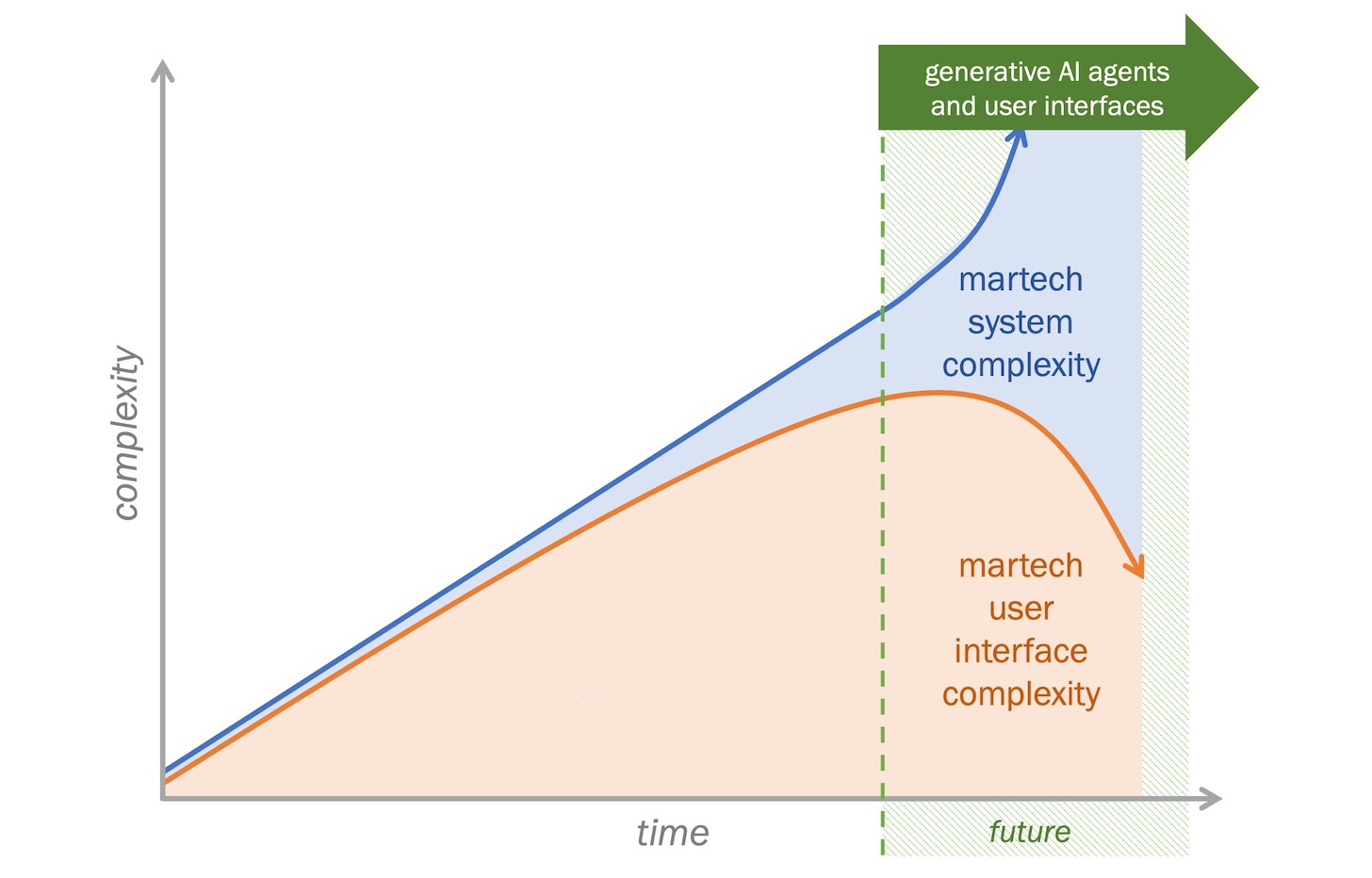

There’s just one catch.
Just like the iPaaS and enterprise automation instruments earlier than them, AI brokers can solely work together with these apps that expose their performance through APIs. (As with RPA, there’s a caveat that AI brokers may additionally “pretend” interactions with human-oriented UIs. Nevertheless it’s a fragile and imprecise method that doesn’t lend itself to strong and dependable digtial operations inside an organization.)
AI brokers are going to drive demand for APIs by way of the roof.
And whereas most martech merchandise have actually improved their API protection over the previous few years, solely 17.3% of the platforms entrepreneurs have on the middle of their stack are rated as having nice API protection, enabling advertising ops to do all the things they need through APIs.
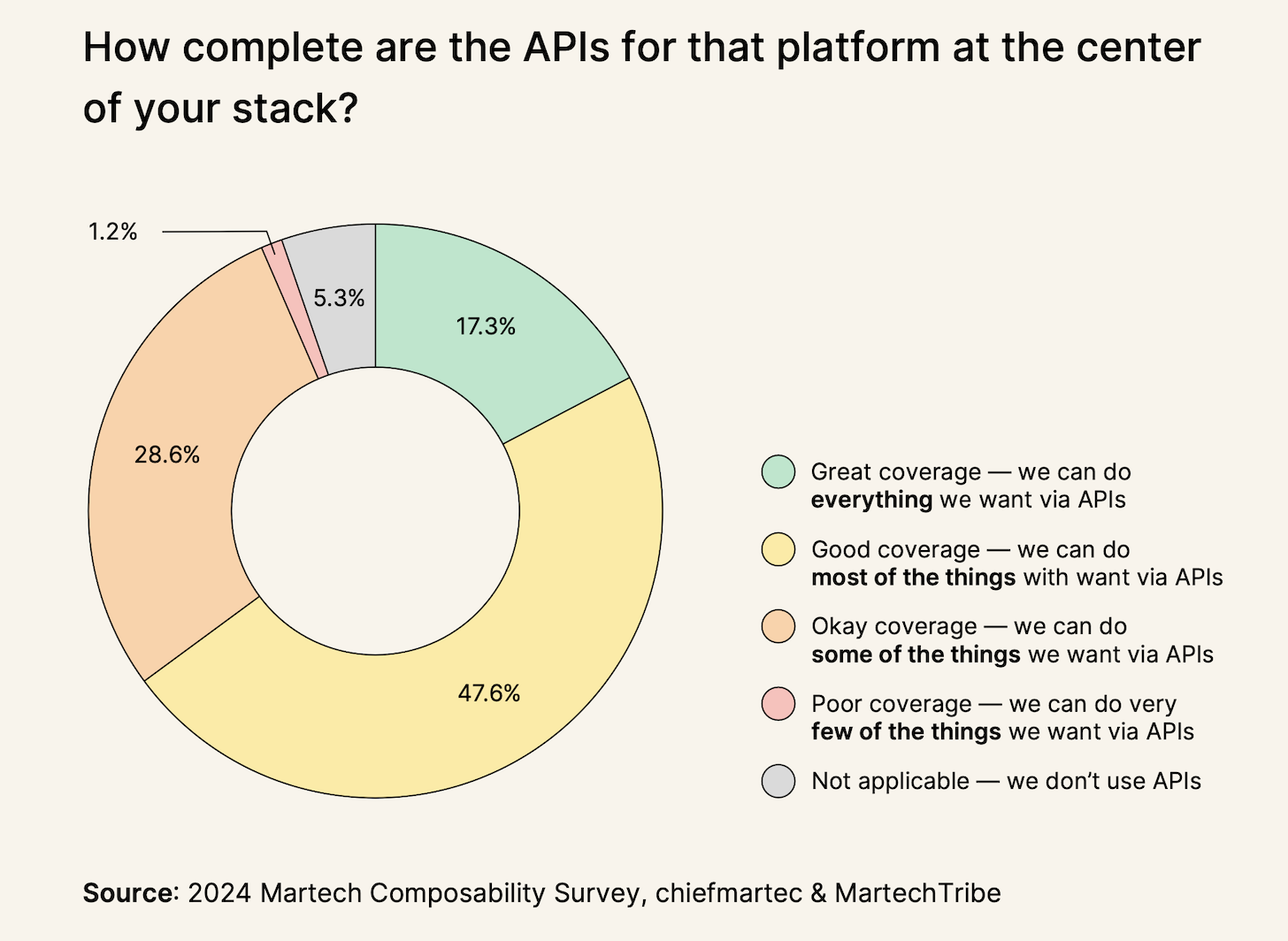

Memo to martech distributors: this is a chance for aggressive benefit. Having higher APIs in your product is a approach to distinguish your self out of your opponents. You may allow your prospects to do extra automations — and shortly extra AI agent magic — by offering nice programmatic interfaces to your product’s performance.
As a result of more and more, your customers aren’t simply going to be people. They’re going to be automations and brokers working on behalf of people. However simply as your closed/misplaced or churn danger will increase if a human person can’t work together with your product, you may anticipate the identical danger will rise if their “synthetic customers” can’t both.
Now, some martech distributors is perhaps anxious that enabling higher API entry to their performance will scale back the utilization of their human-oriented UI. Since human consideration is extraordinarily restricted and extremely invaluable, there may be an incentive to need to catch and maintain on to as a lot of it as potential. It is perhaps tempting to say, “No, you may solely unlock the facility of our product by giving us your full consideration as a human in our UI.”
For many merchandise, I feel that might be a mistake.
Sure, human consideration is efficacious. Nevertheless it’s not the one supply of worth for a vendor. As a military of AI brokers thunders throughout the sphere, these distributors who’re capable of empower such synthetic customers can have higher utilization than those that don’t. Within the Age of AI, utilization is much more vital than UI. More and more, this can be how most martech merchandise monetize.
The Age of AI will even be the Age of APIs.
For extra vital martech developments and insights — together with deeper evaluation of APIs and composability in martech stacks — decide up a replica of our 101-page The State of Martech 2024 Report. You may register for a free copy to be emailed to you right here. (Thanks once more to our sponsors: GrowthLoop, MoEngage, SAS, Syncari, and WordPress VIP.)
